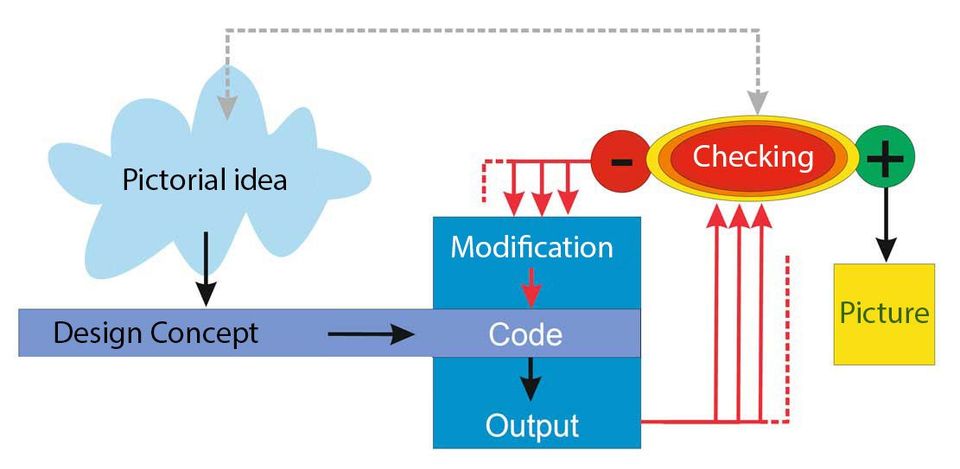Generative Art - an Example by Günter Schulz
Generative art can be created by transforming a pictorial idea first into a design concept and then into a digital code. Its implementation by means of a computer system does not aim at one result but produces an unlimited number of proposals for the realization of the design concept.
In almost all cases, then follows quite a long phase of modifying the code, until the results come close to or even surpass the original pictorial idea.
Finally the artist decides which variant is best suited to create a 'strong' impression.
In almost all cases, then follows quite a long phase of modifying the code, until the results come close to or even surpass the original pictorial idea.
Finally the artist decides which variant is best suited to create a 'strong' impression.
The process is made clear by the following example using six elements:
Elements
A circle, a half-circular arc, a large and a small triangle, two rectangles of different shapes and sizes.
From these elements, a picture is to be created by means of a digital process.
Figure 1 shows the elementary shapes and defines the pivot points (small white circles) around which the shapes can rotate on the background.
From these elements, a picture is to be created by means of a digital process.
Figure 1 shows the elementary shapes and defines the pivot points (small white circles) around which the shapes can rotate on the background.
The underlying grid helps to understand relative sizes: the longest sides of the large triangle and the large rectangle are equal to the diameter of the circle. The sides of the small rectangle (square) are one eighth of the longest sides.
Rules
The elements are combined into modules by the following rules:
Rule 1
Rotation is only in steps of 90°, except for the rectangles, where 45°-rotation is possible.
Rotation is only in steps of 90°, except for the rectangles, where 45°-rotation is possible.
Rule 2
Each element appears in one of eight defined colors assigned to the elements at random. This includes that different elements of a module may be assigned the same color.
Each element appears in one of eight defined colors assigned to the elements at random. This includes that different elements of a module may be assigned the same color.
Rule 3
The rotated and colored elements are combined into a module by placing them on top of each other according to 'size', i.e. starting with the circle, followed by the large rectangle, large triangle, arc, small triangle and finally the small rectangle (square). The latter is only added with a probabiliy of 0.5.
The rotated and colored elements are combined into a module by placing them on top of each other according to 'size', i.e. starting with the circle, followed by the large rectangle, large triangle, arc, small triangle and finally the small rectangle (square). The latter is only added with a probabiliy of 0.5.
Module
Every module alone already fulfills two conditions for a picture which will catch one's attention. It will intuitively be seen as an orderly structure, and there will be burgeoning irritation. Shape mixtures result from several elements being the same color.
There is a lack of clarity that arouses our curiosity. What begins is a mental game of continuous re-interpretation of all sensual stimuli. The observer is captured by "disinterested pleasure" and he wants more. A square tableau consisting of 9 modules extends the playground.
There is a lack of clarity that arouses our curiosity. What begins is a mental game of continuous re-interpretation of all sensual stimuli. The observer is captured by "disinterested pleasure" and he wants more. A square tableau consisting of 9 modules extends the playground.
Tableau
An example of an 81-square tableau shows how quantity can turn into quality. Questions arise: Are there - among these 81 modules - maybe two that are exactly the same? Where are they hiding? How many different modules are possible if you have 6 shapes in 4 to 8 different positions and eight colors available? What part do the 8 different background greys play? Moreover: Could you give one of these 9 by 9 tableaus to every single inhabitant of Germany and not hand out two that are exactly the same? This wouldn't be a problem if you take into account that you can make the 81 modules change places before every printout. There are, in fact, 5.7 x 10 120
different ways of placing 81 modules on a "checkerboard" of 9 x 9 squares. Thus after distributing 82 million pictures among the population of Germany, all other inhabitants of Mother Earth could receive one. And after doing that there would be a considerable rest available for any intelligent life on Moon and Mars or on planets in remote galaxies so far undiscovered.
Considering this inconceivable number of "uniquenesses" the question of an "original" seems paradoxical.







